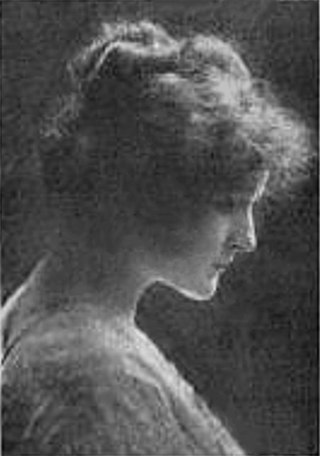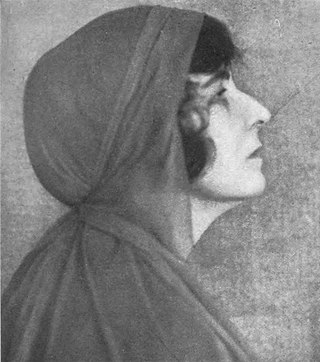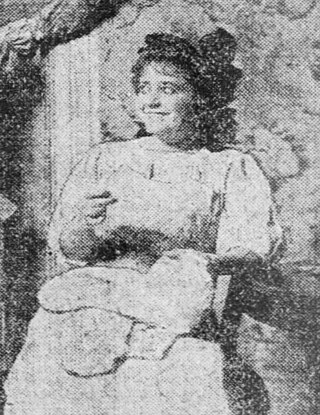Related Research Articles

Romaine Fielding was an American actor, screenwriter, and silent film director known for his dramatic westerns. He was also known as Royal A. Blandin.

The Lubin Manufacturing Company was an American motion picture production company that produced silent films from 1896 to 1916. Lubin films were distributed with a Liberty Bell trademark.

Margarita Fisher was an American actress in silent motion pictures and stage productions. Newspapers sometimes referred to her as "Babe" Fischer.

Fay Tincher was an American comic actress in motion pictures of the silent film era.

Clara Whipple(néeClara or Clarissa or Clarise Brimmer Whipple; November 7, 1887 – November 6, 1932) was an American actress who flourished in theatre from 1913 to 1915 and in silent film from 1915 to 1919. She was also a silent film scenario writer.

Max Bendix was an American concert violinist, conductor, and teacher. He was the first concertmaster of the Chicago Symphony Orchestra and was also the concertmaster of the Metropolitan Opera orchestra. Bendix wrote several works for orchestra and some incidental music as well as songs. In 1899, the Musical Courier called Bendix "the finest American violinist".

Frederic Lewis Tuffley, better known by his stage name, Eric Lewis, was an English comedian, actor and singer. In a career spanning five decades, he starred in numerous comedies and in a few musical comedy hits, but he is probably best remembered today as the understudy to George Grossmith in the Gilbert & Sullivan comic operas of the 1880s who left the D'Oyly Carte Opera Company just in time to give Henry Lytton his big break.

Giroflé-Girofla is an opéra bouffe in three acts with music by Charles Lecocq. The French libretto was by Albert Vanloo and Eugène Leterrier. The story, set in 13th century Spain, concerns twin brides, one of whom is abducted by pirates. The other twin poses as both brides until the first is rescued. The composer chose an extravagantly far-fetched theme to contrast with his more realistic and romantic success La fille de Madame Angot premiered the previous year.

Marcia Moore was an American film and theatre actress in the early 1900s. She had leading roles in multiple productions, including early silent films and vaudeville theatre. Despite the wishes of her father for her to study piano and become a music teacher, Moore's early interest in the stage led her to gather enough money to move to Chicago in order to study the arts at a conservatory there and then join the theatre. She moved between film and stage roles several times throughout her career, including later joining performances in burlesque shows.

Katherine Emmet was an American actress on stage, in film, and in television, and a director of radio plays.

Rosetta Dewart Brice, known professionally as Betty Brice, was an American actress in many silent films.

Jack Pratt, born John Harold Pratt, (1878–1938) was a Canadian film director and actor. He directed several films and acted in dozens more. As a director, his work included screen adaptations of novels.

Minna Pauline Fischer was an Australian lyric soprano and singing teacher in London.

Richard Morris was an American opera singer, stage performer, and silent film actor. Morris was born on January 30, 1862, in Charlestown, Massachusetts. He was 62 when he died in Los Angeles, California on October 11, 1924. Between 1912 and 1924, Richard Morris acted in 59 films.

Queenie Williams, also billed as Little Queenie Williams and later as Ina Williams, was an Australian child actress, singer, comedian, and dancer.

Frances "Frankie" Mann was an American actress, who appeared in over forty silent films between 1913 and 1925.

Velma Virginia Whitman was an American actress who appeared in comedy theatre and silent films during the 1900s and 1910s. A Virginian, she began appearing in theatre roles in 1905 and became known for her portrayal of complicated emotional characters. After appearing with multiple different theatre groups, she established her own in 1906 named Whitman's Comedians and acted as the leading woman for most performances, alongside her husband as the leading man. The large theatre company became well known throughout the American South for their numerous and varied plays up through 1910.

Mattie Edwards (1866–1944) was an American actress who appeared in vaudeville theatre shows and early silent film productions from the 1880s through the 1930s. An African-American, she grew up in Fort Smith, Arkansas and spent her early life as a Deputy Marshal for the town. Later, she joined the P. G. Lowery minstrel group and then films produced by Essanay Studios. She moved between multiple film studios in the years following, including Williams and Walker Co. films in the 1900s, Lubin Motion Picture Company and Ebony Film Company films in the 1910s, before ending her major roles in Comstock-Elliot company and Oscar Micheaux films in the 1920s. She had several smaller film roles and ongoing theatre roles in the decades after, before dying in 1944 at the age of 78.
Melvin Mayo was an American actor and director. He worked for Balboa and Lubin. He portrayed Jim West in the 1915 film Jim West, Gambler and had the title role in the 1916 film A Modern Paul.

George Downing Clarke was a British-born stage and film actor who emigrated to the United States where he where he acted in Broadway theatrical productions and later appeared in films in a decade-long career during the silent era.
References
- 1 2 3 Wright, Allen H. (November 6, 1915). "News Of The Week In And About San Diego". Motion Picture News . Vol. 12, no. 18. Motion Picture News, Inc. p. 72. Retrieved April 13, 2024– via Internet Archive.
- 1 2 "Engagement Is Extraordinary". Shawnee News-Herald . August 20, 1907. Retrieved April 6, 2024– via Newspapers.com.
- 1 2 "Foxy Mr. Bowser". The Grand Island Herald . March 15, 1907. Retrieved April 6, 2024– via Newspapers.com.
- 1 2 "Amusements: Forest Park Theater". Arkansas Democrat . June 22, 1907. Retrieved April 6, 2024– via Newspapers.com.
- ↑ "Music And The Stage". The Los Angeles Times . January 29, 1906. Retrieved April 6, 2024– via Newspapers.com.
- ↑ ""Fra Diavolo" At Forest Park". Arkansas Democrat . June 13, 1907. Retrieved April 6, 2024– via Newspapers.com.
- ↑ "Big Comic Opera "The Beggar Prince"". Americus Times-Recorder . December 13, 1907. Retrieved April 6, 2024– via Newspapers.com.
- ↑ Usai, Paolo Cherchi (2019). The Griffith Project, The Volume 7: Films Produced in 1913. Bloomsbury Publishing. pp. 86–90. ISBN 9781838718961.
- ↑ "Palace Theater". The Morning Press . January 17, 1914. Retrieved April 13, 2024– via Newspapers.com.
- ↑ "Sally's Elopement". The South Bend Tribune . February 21, 1914. Retrieved April 6, 2024– via Newspapers.com.
- ↑ "Footprints of Mozart". The Washington Herald . May 19, 1914. Retrieved April 6, 2024– via Newspapers.com.
- ↑ "At the Palace". The Santa Barbara Daily News and the Independent . January 17, 1914. Retrieved April 6, 2024– via Newspapers.com.
- ↑ "The Dream Dance". The Hutchinson Gazette . August 17, 1915. Retrieved April 12, 2024– via Newspapers.com.
- ↑ "A House of Cards: New Lubin Two-Reeler in Class by Itself". Altoona Tribune . July 2, 1915. Retrieved April 12, 2024– via Newspapers.com.
- ↑ "Remarkable: Three-Reel Drama Called "The Dead Love" Has Been Completed". The Sunday Telegram . May 9, 1915. Retrieved April 6, 2024– via Newspapers.com.
- ↑ ""Nell of the Dance Hall," in Three Parts Will Be Shown Tuesday". Corsicana Daily Sun . October 25, 1915. Retrieved April 12, 2024– via Newspapers.com.
- ↑ "The Strange Unknown". The Moving Picture World . The World Photographic Publishing Company. October 23, 1915. p. 665. Retrieved April 13, 2024– via Internet Archive.
- ↑ "A Night In Old Spain". The Moving Picture World . The World Photographic Publishing Company. October 30, 1915. p. 1014. Retrieved April 13, 2024– via Internet Archive.
- ↑ "Empire Theater". Hartford Courant . November 27, 1915. Retrieved April 12, 2024– via Newspapers.com.
- ↑ "Footlights And Screen". Birmingham Post-Herald . February 8, 1916. Retrieved April 13, 2024– via Newspapers.com.
- ↑ "At The Crosman". The Virginian-Pilot . February 1, 1916. Retrieved April 12, 2024– via Newspapers.com.
- ↑ "Colonial". Norwich Bulletin . April 21, 1916. Retrieved April 13, 2024– via Newspapers.com.
- ↑ "Gripping Drama At The Nelson". The Fairmont West Virginian . February 5, 1916. Retrieved April 13, 2024– via Newspapers.com.
- ↑ "At The Dixie This Week". Bryan-College Station Eagle . February 14, 1916. Retrieved April 13, 2024– via Newspapers.com.
- ↑ "Colonial Theatre". Norwich Bulletin . May 26, 1916. Retrieved April 13, 2024– via Newspapers.com.
- ↑ "Saturday's Bill at the Nelson Theatre". The Fairmont West Virginian . May 12, 1916. Retrieved April 13, 2024– via Newspapers.com.
- ↑ "The Wheat and the Chaff". The Daily Herald . June 13, 1916. Retrieved April 13, 2024– via Newspapers.com.
- ↑ "Casino Theatre". Republican and Herald . August 14, 1917. Retrieved April 13, 2024– via Newspapers.com.
- ↑ "Westchester Theatre". Mount Vernon Argus . August 17, 1916. Retrieved April 13, 2024– via Newspapers.com.
- ↑ "The Return of John Boston". The Salt Lake Herald-Republican . July 9, 1916. Retrieved April 13, 2024– via Newspapers.com.
- ↑ "Brief Stories of the Week's Film Releases". The Nickelodeon . Electricity Magazine Corporation. January 29, 1916. p. 275. Retrieved April 13, 2024.
- ↑ Wright, Allen H. (December 25, 1915). "Two Companies Now at Work for Lubin at Coronado, California". Motion Picture News . Vol. 12, no. 25. Motion Picture News, Inc. p. 116. Retrieved April 13, 2024– via Internet Archive.